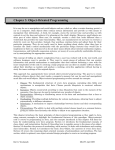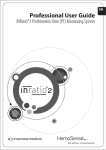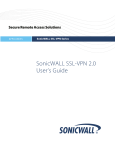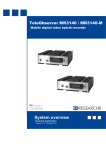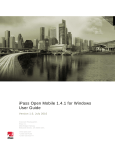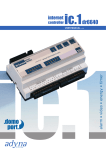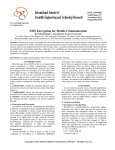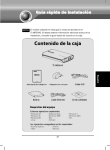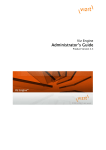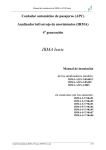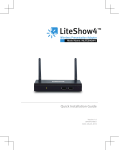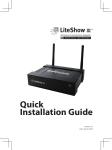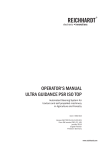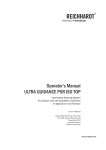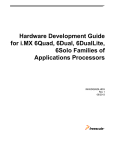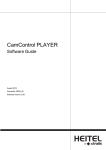Download TeleObserver MR3140
Transcript
TeleObserver MR3140 Mobile hybrid digital video recorder User Manual startup and configuration version 1.5 – firmware 6.0 DResearch – User Manual TeleObserver MR3140 2008-09-19 This document may not be copied, reproduced, summarised, translated or otherwise reproduced without the express permission of DResearch. It has been compiled to the best knowledge of DResearch. DResearch is not responsible for the consequences of typographical or residual errors relating to the user manual which is only informative in nature. DResearch retains the right to make amendments to the contents of the user manual without having any duty to inform third parties. Any change made to the product or its associated software not expressly confirmed by DResearch will result in the termination of the operating licence and warranty. Any company and/or product names are trade names and or legally protected trade marks of the relevant manufacturer. Copyright 2008 by DResearch (Germany) 2 DResearch – User Manual TeleObserver MR3140 2008-09-19 CONTENTS 1 2 3 4 5 6 7 DResearch system overview and general information about MR3140 ................................... 4 1.1 Scope of delivery.................................................................................................................... 5 1.2 Accessories & additional devices........................................................................................... 5 1.3 Safety advice.......................................................................................................................... 6 1.4 Warranty................................................................................................................................. 7 1.5 Certifications, standards and conformities ............................................................................. 7 1.6 Scope of use .......................................................................................................................... 8 1.7 General installation information.............................................................................................. 8 1.8 Temperature range ................................................................................................................ 9 1.9 System components and device features ............................................................................ 10 The MR3140 mobile digital video recorder (mDVR) in detail ................................................. 13 2.1 Device description................................................................................................................ 13 2.2 Changing and inserting the removable disk......................................................................... 14 2.3 Significance of the status LEDs ........................................................................................... 15 2.4 Device interfaces.................................................................................................................. 16 2.4.1 Analogue video inputs 1 ... 4 – connection of analogue CCTV cameras ........................ 16 2.4.2 LAN Interface – connection of IP network cameras or other devices.............................. 16 2.4.3 Video Out 1, 2 – connection of control monitors.............................................................. 17 2.4.3.1 Sequential video output and multiviews.................................................................. 17 2.4.3.2 Display of information and system events (OSD) ................................................... 18 2.4.4 Power supply for the device and cameras....................................................................... 19 2.4.5 COM 1 – Serial data transmission and GPS connection................................................. 20 2.4.6 COM 2 Interface – External modem connection............................................................. 20 2.4.7 COM 3 and COM 4–Interface (IBIS and RS485)............................................................. 20 2.4.8 The audio interface .......................................................................................................... 21 2.4.9 GPIO-interface – detector inputs and switch relay outputs ............................................. 21 2.4.10 GPIO-Interface ............................................................................................................ 22 2.4.11 “Ext. Devices“ Interface – IBIS, CAN and RS485 ....................................................... 23 Device Configuration - The CMS and its main menu .............................................................. 24 3.1 SystemManagement –module for device configuration....................................................... 25 3.1.1 The device configuration.................................................................................................. 27 3.1.1.1 System :: Basic settings .......................................................................................... 28 3.1.1.2 System :: Time ....................................................................................................... 31 3.1.1.3 System :: Passwords............................................................................................... 32 3.1.1.4 System :: Version .................................................................................................... 33 3.1.1.5 Devices :: Cameras................................................................................................. 33 3.1.1.6 Devices :: IP-Cameras ............................................................................................ 35 3.1.1.7 Devices :: Detectors ................................................................................................ 36 3.1.1.8 Devices :: Relays .................................................................................................... 38 3.1.1.9 Devices :: Audio ...................................................................................................... 38 3.1.1.10 Connectors :: GPS.............................................................................................. 39 3.1.1.11 Connectors :: Network ........................................................................................ 40 3.1.1.12 Video output :: QuadView ................................................................................... 41 3.1.1.13 Video output :: Transfer order............................................................................. 41 3.1.1.14 System events .................................................................................................... 42 Update & Reset, maintenance, problem analysis and technical support ............................. 44 4.1 Update and Reset of the device via the web interface ........................................................ 44 4.2 Maintenance, cleaning and care of the system.................................................................... 45 4.3 Problem analysis and resolution .......................................................................................... 46 4.4 Technical support by the manufacturer................................................................................ 47 Technical data ............................................................................................................................. 48 Technical drawing ...................................................................................................................... 50 Abbreviations .............................................................................................................................. 51 3 DResearch – User Manual TeleObserver MR3140 1 2008-09-19 DResearch system overview and general information about MR3140 Congratulations on the acquisition of your MR3140! Dear customer, thank you for deciding to purchase an MR3140 mobile hybrid recorder, we are most grateful for your custom. You have made an excellent choice in acquiring this device, a top quality product from DResearch. The MR3140 is a compact digital unit for recording video sequences from analogue and digital cameras as well as other associated data (IBIS and GPS). With industrial styling and a robust nature, the device is intended for mobile and static use under the severest conditions. Because of the particular application requirements of mobile CCTV monitoring, the MR3140 is designed to be a compact, efficient system with a long service life. Owing to its tolerance of temperature variations and its resistance to vibration and shocks, corrosion, dust and moisture, the unit is particularly well equipped for flexible use in vehicles. The system digitizes and records up to 4 analogue video streams. Alternatively up to 8 digital video streams from IP cameras can be recorded from a local network. The MR3140 also has many interfaces for configuration, expansion, maintenance and integration in all-in-one systems. As many as 12 IP cameras can be set up in the network for display on a control room monitor. Please take some time to read the user manual carefully so that you are familiar with the complete functional scope of the system and its application requirements. The documentation for the device is provided on the software CD supplied with the device. We wish you every success in working with the MR3140 mobile hybrid recorder! DResearch mDVR at a glance Analogue recording Digital recording Video-IN analogue (max.) Video-IN digital (max.) Video-OUT Transmission via SMS, Video (GSM, GPRS, EDGE) if an alarm is triggered GPS IBIS Max. capacity HD in GB Motion detection Sabotage detection Encryption/digital signature Digital inputs Digital outputs/switch relays RS232/485 Video management software incl. MR3040 MR3140 MR3240 MR3180 TO1200 TO3100 yes 4 2 yes ** yes yes 4 8 2 yes ** yes 8 2 yes** yes yes 8 8 2 yes ** 4 yes * yes 8 1 yes * yes yes 250 yes yes yes 6 4 yes yes yes yes 250 yes yes yes 6 4 yes yes yes yes 250 yes yes yes 6 4 yes yes yes yes 250 yes yes yes 8 2 yes yes yes yes 6 4 yes yes yes * yes * 160 yes 8 6 yes yes * optional, depends on type of device and/or software module key ** only for SMS transmission via external device 4 DResearch – User Manual TeleObserver MR3140 1.1 2008-09-19 Scope of delivery MR3140 digital hybrid recorder 160 GB HDD removable hard disk Software for configuration and analysis (Central Monitoring Software - CMS) Licences for the CMS Product CD with software and documentation 1.2 Accessories & additional devices The devices can be expanded with various accessories. For a detailed list of all the accessories offered by DResearch, please refer to the current product catalogue. For other information and ordering of accessories please contact your system integrator or our team direct. Assortment of additional devices for the system: Power supply unit 24V/2,5A Power – plug (ready-made 75cm cable with pin sleeves) MO-bearing for vibration damped mounting Mounting kit Service cable (Crosslink and patch cables, serial service cable) Plug set GPIO, Plug set Ext. Device Power-over-Ethernet switch (PoE) for supplying power to IP cameras DC/DC transformer (various input voltages, Out: 12-24V) Removable hard disks in various capacities 80 - 250 GB Video- and network cables (CAT 5; 6 ) in various lengths GPIO tester Assortment of additional devices to extend the system WLAN module Various versions of GPS receiver and GSM antenna Modems for sending SMS Rail media coupler Various analogue and IP network cameras Colour and b&w surveillance monitors for fitting into vehicles (trucks, buses, trams, trains) A complete installation in a rail carriage when expanded with accessories could look like this:* * This is an illustrative example. Up to 8 cameras can be recorded. 5 DResearch – User Manual TeleObserver MR3140 1.3 2008-09-19 Safety advice Incorrect handling can, at its worst, lead to personal injury or destruction of the device, and/or the termination of the guarantee. Therefore please be sure to note and follow the advice below before operating the device. Never try to insert objects into any device openings since this could cause short-circuits or deliver electric shocks because of the voltage inside the unit. Only use original parts or products recommended by the manufacturer in the operation of the equipment. If you have a problem please consult your system integrator. Avoid installing equipment where it could be exposed to excessive smoke, dust, vibration, chemicals, moisture, heat, direct sunlight or electromagnetic fields. Such exposure can have a detrimental effect on the operation of the device and – in the worst case – can cause damage to the device. Never operate the device in locations where there is a danger that water might penetrate the device. When connecting up the device with the peripherals ensure that the cable is not under tension. Ensure all cables are installed properly. Only remove the hard disk from the device when all the LEDs on the front panel are off. To remind you this warning is printed on the front of the removable hard disk. Remove only, when all LEDs are off! This is an (EMC, EN 55022) Class B system and can be used in all environments. 6 DResearch – User Manual TeleObserver MR3140 1.4 2008-09-19 Warranty The warranty terms for materials and manufacturing faults are, unless otherwise agreed by special negotiation, set out by DResearch Digital Media Systems GmbH in its General Terms and Conditions. The General Terms and Conditions are to be found in the documents supplied. No further, expressed or tacit guarantees are accepted. The manufacturer is not responsible for claims arising from the improper handling or faulty installation by third parties. The warranty is terminated if repairs or interventions are made by people who have not been authorised by the manufacturer. Claims arising from the inappropriate use of the equipment, incorrect maintenance or the use of accessories not recommended by the manufacturer are not covered under the terms of the warranty. Opening the device inevitably leads to the cancellation of all existing guarantee cover, guaranteed rights and agreed warranties. The supplied software and installation pack presuppose a conflict-free operating system. Solving problems relating to this require detailed knowledge of the systems used or their complete reinstallation. The manufacturer makes no guarantees that programs or systems operated by the user will deliver the desired benefits. If a product is returned under the terms of the warranty this is always to be agreed in advance with the supplier, otherwise the return will not be processed. If returning an item, you will be given a returns number which is to be used throughout the procedure. The manufacturer takes no responsibility for damage or insurance during transit. Cash on delivery and ‘carriage forward’ shipments are not accepted. 1.5 Certifications, standards and conformities The device is made to current safety and reliability standards (state: 09/2008) for use in a variety of environments. It was designed specially for use in trucks and locomotives and meets current requirements of various European standards. Certifications, standards and conformities: CE compliant to EN55022 class B RoHS conformity Conformity to European rail standard EN50155 e1 certification from the German Federal Bureau of Motor Vehicles and Drivers (KBA) Conformity to European EMC guidelines Vibration IEC 61373 (9) and shock IEC 61373 (10.5) Heat & fire resistance DIN 53438-2, DIN 5510-2 7 DResearch – User Manual TeleObserver MR3140 1.6 2008-09-19 Scope of use Public transport sectors Trams, suburban railways, underground railways, buses, local and long distance trains and other vehicles Distribution, logistics and transport sectors Secure cash transport, transportation of hazardous loads, trailers and storage areas, high-bay warehousing and distribution centres, etc.. Housing and construction industry Local properties, lifts and entrance halls as well as building sites. Industry and commerce Builders yards, industrial sites, waterworks and water treatment works, pumping stations, power stations, transformer substations, wind farms, geothermal power stations, retail branches, shopping centres, etc. Maritime - Offshore Locks, sea level measuring stations, oil drilling platforms, off-shore wind farms, etc. Private sector Holiday cottages, residential property, bungalows, boats, yachts, other vessels. Caravans, camper vans, etc. 1.7 General installation information Power supply The device must be plugged into a buffered power supply (UPS or unswitched supply/permanent positive). Do NOT use the on board train power supply switch to turn the system on. Use the ignition. Ensure that the device is wired up exactly as described in the manual. Ensure there is a constant power supply of 12-24 VDC. Temporary power outages will be tolerated by the device but they are always to be avoided and can lead to system failures and permanent damage to the equipment (e.g. from lack of proper vehicle battery maintenance). The UPS must be a device which has been recommended by the manufacturer and has valid certification for the application type. Any damage resulting from disregarding this advice will not be covered by any guarantee or warranty. Cable length between device and cameras Long connection paths between device and cameras have detrimental effects on the quality of the video signals. Select camera positions so that as much as possible of the area to be monitored can be covered with minimum cable lengths. Your system integrator will help you with the design of the system. 8 DResearch – User Manual TeleObserver MR3140 2008-09-19 Ventilation and cooling Avoid installations where heat can build up. The equipment is designed to function without the need for a fault-prone fan, but adequate air circulation needs to be provided round the cooling fins. Mounting The device has 2 guide rails on the top and bottom which take mounting screws. If at all possible, mount the device on a mounting plate which can also take the necessary additional components such as a transformer and connection block. The device must not be mounted with the hard disk drive aperture facing down! When fitting ensure that it is possible to change the removable hard disks easily! 1.8 Temperature range Storage temp.: Operating temp.: Humidity: maximum + 70°C 0°C to + 55°C (normal HDD) 0°C to + 70°C (HT- HDD, SSD) 10 … 90 % (not condensed) When using conventional data storage devices (HDD) the unit will automatically shut down when it reaches its temperature limit of + 55°C (for normal HDD) in order to protect the hard disk. When the temperature reduces to below this limit, the device will automatically switch back on. This temperature-dependent switching event is stored in a log file. 9 DResearch – User Manual TeleObserver MR3140 1.9 2008-09-19 System components and device features The complete system consists of three different modules which communicate with each other via a proprietary software data protocol which is the same irrespective of the operating system. The device MR3140 Data recording and storage of video streams with metadata according to the predetermined configuration Storage on a removable hard disk Connection of a control monitor with OSD in quad view Function and configuration: see following chapter Default IP address of the device when shipped: 192.168.0.1 Service computer and analysis station Usually the review station is used for analysing the recorded data. A service laptop is often employed for installation, configuration and system maintenance. A standard commercial computer can be used. Currently DResearch offers two software packages: Central Management Software (CMS) With the modules Vision, ImageFinder and SystemManagement for Visualisation of recorded data (video, add. data) Searching recorded data according to freely configurable parameters (e.g. time, events etc.) Display of live video sequences (incl. additional data) Device configuration Operating systems (OS) supported: Windows XP Prof. and Vista ImageFinderNX The successor to the CMS ImageFinder package – for investigating and analysing recorded data. It also enables backing up of video data from the recording devices. (Operating systems: Windows XP Prof., Vista). Usable only in conjunction with the USB-TTU. For more details about the software packages refer to the respective manuals. The TeleObserver Transfer Unit (TTU) This separate device (USB-TTU, MR40-TTU) has the following uses: takes the removable hard disk for the evaluation/analysis of data formats the hard disk activates removable hard disks and decodes data (not for USB-TTU when using DR.Secure encryption) displaying synchronous video images 10 DResearch – User Manual TeleObserver MR3140 2008-09-19 Detailed information you will find in this manual and the data sheet. System specification – an overview Hybrid recorder for recording video, audio and metadata, designed for buses, trains, trams and other vehicles, certified to e1 and EN 50155 4 x video-in analogue (BNC), 8 x video-in to record from IP network cameras (AXIS, Mobotix and others up to 1 Megapixel, 1280 x 1024 Pixel) 2 channel audio recording (e.g. for the documentation of the driver communication) removable hard disk: up to 250 GB HDD, 64 GB SSD 2 x video-OUT for analogue up to 12 IP network cameras, split screen display and onward signal switching recording of metadata such as IBIS (VDV 300), GPS, CAN-Bus optional Interfaces: RS232, RS485, Ethernet, IBIS 6 digital alarm inputs and 4 outputs for switch relays Integrated power supply for 4 analogue cameras Compact, robust industrial design for use in the most difficult conditions with protection against vibration Stable cast aluminium housing, maintenance-free through fan-free operation Software and data management Live video pictures, search and playback function and fast video download via an Ethernet-Interface Configuration and management software with ergonomic graphical user interface Expanded event and information management, including IBIS / GPS metadata Support for alarm and fleet management Data encryption, watermark, sabotage recognition, role-based access management, motion detection Flash based pSOS operating system and hardware control system MJPEG and H.264 (MPEG-4 AVC) picture compression with recording rates up to 200 frames per second SMS support for alarm events as well as for maintenance/service-support (GSM modem required) Feature Configurable video recording Description Recording of video sequences from up to 8 cameras (hybrid operation of analogue and IP cameras) in automatic generated archives (one ring, alarm and pre-alarm archive per camera). Maximum of 25 pictures/s for analogue cameras to the 4 video inputs Recording of up to 8 IP cameras with a maximum of 25 pictures/s per camera Definable setting for maximum age for the video footage Configurable picture resolution (picture format) The picture format has to be determined before recording begins! Recording formats from analogue cameras CIF (352 x 288 = 101 376 Pixels) Half frame/2CIF (704 x 288 = 202 752 Pixels) Recording formats from IP cameras: The IP camera picture format has to be determined in the camera set up – not via CMS! Configurable picture quality For each analogue camera there are 5 different settings for the picture quality of the recorded video footage. The picture quality from the IP cameras is determined by the camera configuration settings. 11 DResearch – User Manual TeleObserver MR3140 Feature Configurable alarm recording 2008-09-19 Description Pre- and post-alarm recording times are configurable Events can be used to start alarm recording Data recorded with this feature are marked as such. The alarm footage is not automatically overwritten. The maximum age of the alarm sequences can be determined. Activated alarm recording display If alarm recording is activated, this is indicated by the yellow HD LED and it is displayed on the control monitor. Configurable metadata recording Besides video footage, additional data such as date/time, camera name, IBIS and GPS data are recorded. Calling up status information Information about the current status of the device is indicated via the devices LEDs and displayed on a control monitor (OSD). Display of the event log Information about the device is recorded in the event log. The log can be viewed in ImageFinder. System events Indicate the various device and archive conditions. They can be viewed on a control monitor (OSD). Motion detection Trigger-level-controlled motion detection Motion detection can be limited by masking off particular areas of the picture. Configurable actions in response to motion detection, e.g. alarm recording and/or switching relays.. Camera sabotage Trigger-level-controlled camera sabotage detection Configurable actions in response to camera sabotage, e.g. relay switching 12 DResearch – User Manual TeleObserver MR3140 2 2.1 2008-09-19 The MR3140 mobile digital video recorder (mDVR) in detail Device description The MR3140 is one part of the complete recording system and works without a fan. The housing is made from non-rusting, maintenance-free material. The data transmission and recording processes in the device are encrypted to prevent unauthorised access to the data. The file and security operating systems used prevent loss of important files if there is a power outage and therefore maintain continuity. The device forms the switching centre and link between all other system components. It provides the interfaces for the connection of cameras, peripherals such as WLAN modem, GSM modem, PoE switch, driver monitors, relays and switches as well as other components. Front view of the MR3140 Ethernet COM1 RS 232 Removable storage disk State - LEDs HD-lock Rear view of the MR3140 Power supply Digital I/O RS 485, IBIS, CAN (optional) COM2 RS 232 Audio Video-OUT 1, 2 (analogue) Video-IN 1 .. 4 (analogue) 13 DResearch – User Manual TeleObserver MR3140 2.2 2008-09-19 Changing and inserting the removable disk the MR recorder series’ removable disk Please ask your system integrator or the manufacturer about the sizes and models currently available. In MR3140 devices use only the hard disks provided and pre-formated by DResearch. Only hard disks with the same capacity should be used within each fleet. For more information and for ordering hard disks please contact the sales team (E-Mail: [email protected]). Use only original hard disks from the manufacturer! Otherwise all existing warranties and guarantees are invalidated. Only remove the hard disk when all the LEDs on the front of the device are off! Removing the hard disk before the LEDs go out results in damage to the device. All warranties and guarantees are thereby invalidated! To prevent any manipulation of the data, the hard disk is adopted by the device. This process happens when the device starts up with the hard disk for the first time. Only after this can recording start. To prepare the device for recording for the first time proceed as follows: Switch the device off and wait until all the LEDs have gone out (by unlocking the HD lock) – this takes several seconds Without using physical force carefully insert a formatted (!) removable hard disk (label upwards) in the carrier guides. Lock the HD lock again. The system will start again (so long as the power is on). The hard disk capacity will be automatically allocated to the camera archives by the software. No further intervention is necessary. If you anticipate exchanging hard disks between different devices (so-called swap) then the following details are important: Make sure you read the details in section System – basic settings! The hard disk is a sensitive part of the system. To ensure constantly reliable functioning we recommend that the hard disks are given and intensive check-up in the TTU every 3 months. 14 DResearch – User Manual TeleObserver MR3140 2.3 2008-09-19 Significance of the status LEDs On the front of the unit there are four coloured LEDs which indicate the current status of the device. At any time you can determine the current status of the device from the colour codes. We recommend that you print out the following table and keep it with your service documents. LED State Description Status off Device is switched off green Device is ready for operation orange Device is booting or shutting down red Error – contact the service department! HD off Device is not recording (recording) green Actively recording into the ring archive (normal) orange Actively recording into the alarm archive (alarm event) orange flashing HD will be adopted by the device in 30 seconds red Hard disk is not available or could not be recognised/adopted by the device. (state of the device) No recording on the hard disk other errors Link off No connection between PC and device (LAN-connection) green Active data transmission, connection between PC and device orange Not busy red Error – no communication Archive off Archives cannot be recognised (fault) (archive fill level) green 0% - 60% of the capacity full orange > 60% - 80% of the capacity full red > 80% - 100% of the capacity full The codes listed here could be changed by the manufacturer. If in doubt contact your system integrator or the manufacturer. 15 DResearch – User Manual TeleObserver MR3140 2.4 2.4.1 2008-09-19 Device interfaces Analogue video inputs 1 ... 4 – connection of analogue CCTV cameras Up to four standard commercial CCTV cameras can be connected via the BNC connections IN-1 to IN-4 (rear of device) provided they have BNC connectors and deliver an analogue CCIR standard (CVBS, PAL/NTSC) signal. The operating voltage for the cameras is provided by the MR3140 recorder itself (12V). Before video footage can be recorded from a camera (analogue and IP), video recording for this camera has to be explicitly activated in the Central Monitoring Software (See configuration chapter). Note that you can only ensure a stable camera power supply of 12 V if the power supply to the recorder is always over 13V. 2.4.2 LAN Interface – connection of IP network cameras or other devices Pin 1 Name Tx+ Description Transceive Data+ 2 Tx- Transceive Data- 3 Rx+ Receive Data+ 4 Not used 5 Not used 6 Rx- Receive Data- 7 Not used 8 Not used This interface supports a bandwidth of 100 Mbit Table 1: Pinout of the RJ45 network interface Using the RJ45-interface (LAN, Ethernet) and a patch cable (CAT 5 or higher) you can connect the device with other external devices. This might be: A computer - for configuration and/or control through the CMS External devices - such as a WLAN-modem, a switch, a single IP-camera or several IP-cameras over a switch Connection of IP-cameras Up to 12 IP cameras can be connected via the LAN interface and an external switch (see system diagram on page 4). Video recording can be activated for up to 8 IP cameras, the remainder can be set up in parallel to provide video pictures on an monitor. 16 DResearch – User Manual TeleObserver MR3140 2008-09-19 Please note that the device does not support Power over Ethernet (PoE). Depending on the type of cameras used (e.g. AXIS 209 FD-R) their power supply has to come via a separate power supply unit or the PoE supply belonging to the external switch. Consult the relevant camera manual for power supply details. Activation of cameras is dealt with in chapter 3. Only use DResearch recommended accessories! 2.4.3 Video Out 1, 2 – connection of control monitors Two control monitors for monitoring the cameras can be connected in parallel via the recorder’s analogue video outputs. This enables the camera pictures to be viewed in two different locations. The cameras to be displayed on the monitors can be configured in the SystemManagement software module. All 4 analogue and up to 12 IP cameras can be displayed using a video switcher and/or in multi-view (single, quad, nona etc.). The position of the individual camera signals/video pictures within the screen and the switching sequence can be individually configured. It is not necessary for the relevant camera to be activated for recording in order to display video pictures. Although only 8 IP cameras can be activated for recording, up to 12 IP cameras can be connected to the recorder via the external switch and all 12 video signals can be displayed. Please note that displaying video makes additional demands on the device. Too many video signals can lead to reduced frame rates and hesitation in playback. Because of this only set those cameras for video OUT which are absolutely necessary. Usually it makes sense only to set up those cameras which cover sensitive areas (vehicle entry area or rear view camera). A suitable monitor is available directly from DResearch. Please look at our current product catalogue or contact us. 2.4.3.1 Sequential video output and multiviews Live pictures from the linked cameras can be switched through in sequence to be shown on the control monitor – this is controlled via a digital input. Configuration is dealt with in full in chapter 3. 17 DResearch – User Manual TeleObserver MR3140 2.4.3.2 2008-09-19 Display of information and system events (OSD) Using OnScreenDisplay the recorder shows additional information in the form of symbols and texts when particular system events and alarms occur. The following information and system events are displayed: Symbol Significance Name of the warning device Description Symbols for the six digital inputs IN1 to IN6 Displays the number of the active alarm or electromechanical lock at the bottom of the screen. ⊗ - Alarm in the last hour Automatically increases the duration if another alarm is activated or deactivated within this period. * Alarm recording active Alarm sequence recording HD (!) No disk found No disk or disk faulty HD (60%) Alarm archives 60% full HD (80%) Alarm archives 80% full At least 60% (or 80%) of the hard disk capacity has been written with alarm footage. HD (full) Alarm archives full No further alarm sequence recording possible Archiving and release of the alarm archive in ImageFinder GPS GPS fault Device not receiving GPS signal IBIS IBIS-Bus fault Device not receiving IBIS signal RMC RMC fault Fault in the Rail Media Coupler IP (1..8) Camera number IP camera video signal missing A (1..4) Camera number Analogue camera video signal missing or camera has been sabotaged or covered. (A = Camera group A = 1..4) Table 2: Alarm system conditions and events indicators 18 DResearch – User Manual TeleObserver MR3140 2.4.4 2008-09-19 Power supply for the device and cameras The interface provides power for the device itself and makes camera voltage available for the analogue cameras. The device is switched on and off via a connection through the vehicle’s ignition switch. Interface A4 2 5 1 4 Pin A1 Name Camera_POWER(+12V) Description + camera power supply A2 POWER_IN (12V – 32V) + power supply A3 GND - power supply A4 Camera_GND - camera power supply 1 - 2 - 3 Input1+ Ignition, high, galvanically separated (optocoupler) 4 Input1- Ignition, low, galvanically separated (optocoupler) 5 - 3 A3 A2 A1 Table 3: Pinout of the Power interface Ensure there is a constant power supply of 12-24 VDC on Pin A2. Temporary power outages (e.g. from lack of proper vehicle battery maintenance) will be tolerated by the device but they are always to be avoided and can lead to system failures and permanent damage to the equipment. The UPS must be a device which has been recommended by the manufacturer and has valid certification for the application type. Any damage resulting from disregarding this advice will not be covered by any guarantee or warranty. Example showing connection of device and cameras +12V Ignition PIN3 (HIGH) Zündung High Side – PIN3 Zündung – PIN4 Ignition Low PIN4Side (LOW) Power +12V/+24V USV The device will be switched on when a high power level is at Pin 3 "Ignition High Side" (min. 6 V). PIN 4 has to be connected to the return potential (ground). GND USV oder constant power Dauerplus 19 DResearch – User Manual TeleObserver MR3140 2.4.5 2008-09-19 COM 1 – Serial data transmission and GPS connection The COM1 port (RS232) on the front of the recorder is used (as a service interface) for maintenance of the device or for connecting external devices such as a GPS receiver or modem. The interface (D-SUB 9, male) is configured as standard for RS232: Interface (male) Pin 1 Name CD Description Carrier Detect 2 RxD Receive Data 3 TxD Transmit Data 4 DTR Data Terminal Ready 5 GND System Ground 6 DSR Data Set Ready 7 RTS Request to Send 8 CTS Clear to Send 9 RI Ring Indicator Table 4: Pinout of interface COM 1 GPS receiver connection Note that the only navigation systems and GPS receivers supported are those recommended by DResearch. The GPS receiver can be connected directly to the COM1 port. The port parameters can be configured in SystemManagement GPS. (See Chapter 3, Configuration) Use as service interface The service interface allows analysis of the device using a terminal. This should only be carried out by authorised experts. This requires the use of a fully wired serial service cable from DResearch. 2.4.6 COM 2 Interface – External modem connection An external modem for sending SMS messages can be connected via the COM2 (RS232) port. This is automatically recognised by the recorder. The only modems which are supported are these ones available as accessory. A connected modem is automatically recognised by the recorder. An SMScapable software receiver must be installed on your PC. This is not included in the shipment! When operating a GSM modem for the first time the access to the relevant providers has to be configured (PIN, AT commands etc.) before inserting the SIM card and connecting the modem to the MR3140 Incorrect operation can lead to the SIM card being blocked! DResearch takes no responsibility for the costs associated with a blocked SIM card if the above instructions are ignored and the equipment is operated improperly! 2.4.7 COM 3 and COM 4–Interface (IBIS and RS485) Ports COM 3 and COM 4 (RS485) are used for connecting the IBIS-Bus (COM 3) and any external RS485 devices (e.g. a GPS-receiver). Both ports lead out via the pins on the unit’s Ext. Device external interface. 20 DResearch – User Manual TeleObserver MR3140 2.4.8 2008-09-19 The audio interface Use the audio adapter cable which is provided in the accessories to connect external audio devices to the recorder. The interface (D-SUB 9, female) is wired as follows: Interface 5 9 1 Pin 1 Name Audio PWR2 Description Microphone phantom voltage 2 2 AudioIn2 Audio input 2 3 GND Audio GND 4 AudioIn1 Audio input 1 5 Audio PWR1 Microphone phantom voltage 1 6 GND Audio GND 7 GND Audio GND 8 GND Audio GND 9 GND Audio GND 6 (female) Table 5: Audio interface pin layout 2.4.9 GPIO-interface – detector inputs and switch relay outputs Sensor input 1 ... 6 Each of the 6 available inputs is constructed as shown in the adjacent circuit. Sensor systems can be connected as desired depending on requirements. This allows the MR3140 to be fully integrated within existing systems. Recording module Relay output 1…4 Each of the 4 relay outputs is constructed as shown (left). Here too the connection options enable the recorder to offer full flexibility for the connection of devices and systems. It is possible to connect indicators, diodes and bulbs or to control other whole systems directly. Recording module 21 DResearch – User Manual TeleObserver MR3140 2008-09-19 2.4.10 GPIO-Interface The GPIO interface (HD-SUB 25, female) provides for the connection of alarm detectors. For this use the GPIO connector set which can be obtained as an accessory from your system integrator or DResearch. Up to 6 sensors (optocoupler inputs) and 4 switch outputs (relays) can be connected. Pin Name Description 1 OUT2COMMON Relay output 2 – common contact Relay output 2 – unprotected contact 15 OUT2-NC 3 OUT2-NO Relay output 2 – make contact 4 OUT1COMMON Relay output 1 - common contact Relay output 1 - unprotected contact 18 OUT1-NC OUT1-NO Relay output 1 - make contact 19 Reference potential for digital inputs 20 GND IN6 Digital input 6 IN5 Digital input 5 IN4 Digital input 4 IN3 Digital input 3 IN2 Digital input 2 IN1 Digital input 1 2 5 6 7 8 Name Description 14 OUT4COMMON Relay output 4 - common contact OUT4-NC Relay output 4 - unprotected contact 16 OUT4-NO Relay output 4 - make contact 17 OUT3COMMON Relay output 3 - common contact OUT3-NC Relay output 3 - unprotected contact OUT3-NO Relay output 3 - make contact GND Reference potential for digital inputs GND Reference potential for digital inputs GND Reference potential for digital inputs GND Reference potential for digital inputs GND Reference potential for digital inputs GND Reference potential for digital inputs 21 9 22 10 23 11 24 12 13 Pin 25 Table 6: Pinout of interface general purpose input/output (GPIO) 22 DResearch – User Manual TeleObserver MR3140 2008-09-19 2.4.11 “Ext. Devices“ Interface – IBIS, CAN and RS485 External Devices interface - Pinout Pin 1 … …13 The (HD-SUB-25, male) socket marked Ext. Devices on the recorder is an RS485 interface. This is shown as COM4 in the setup configuration. This connection is used for the connection and integration of an IBIS system or a rail media coupler. The interface 14 25 is also suitable for connecting an external GPS receiver. A connection for a CAN bus ** is offered as an additional option. To use this interface the plugset ext. device is required. This can be obtained from your system integrator or from the manufacturer. Pin 1 Name Pin 14 Name GND Description Ground WBSD Description IBIS Call -Bus Signal 2 CAN_GND** CAN Ground** 15 WBMS IBIS-GND-Call-Bus 3 CAN_L** CAN_L Bus Signal** 16 WBED IBIS-Response-Bus Signal 4 CAN_H** CAN_H Bus Signal** 17 WBME IBIS-GND- Response -Bus 5 reserved Ground 6 7 18 GND GND Ground 19 not used GND Ground 20 reserved not used reserved 8 reserved 21 9 reserved 22 10 reserved 23 not used 11 GND Ground 24 GND Ground 12 RS485A RS485 Signal A 25 GND Ground RS485B RS485 Signal B 13 * IBIS = COM3, RS485 = COM4 ** The hardware is prepared to support a CAN-Bus and can be offered. Contact DResearch about this. Table 7: Pinout of interface Ext. Devices 23 DResearch – User Manual TeleObserver MR3140 3 2008-09-19 Device Configuration - The CMS and its main menu . To set up a connection to the device, an outstation with the name of your choice (e.g. MR3140_001) and the IP address of the MR3140 (Default: 192.168.0.1) has to be set up in the CMS module SystemMangement Outstaion. The CMS consists of the modules Vision, ImageFinder and SystemManagement. Only the system management module is relevant for the configuration of the recorder. There is a detailed description of the CMS software in the software manual. Vision - Display of live pictures With the MR3140 this module can be used for the installation of a whole system for adjusting and function checking the cameras. You can check the adjustment of the cameras with it. Proceed as follows: Create a connection between PC and device (Ethernet) Start the CMS and afterwards Vision Connection to the device Connect After successfully establishing the connection you will see the camera pictures. ImageFinder – search of recorded data Enables the searching of recorded video data. The various different types of archives are shown colourcoded: ring archive (green), alarm archive (red) and pre-alarm archive (yellow). Archives are automatically established for each camera which is activated for recording in the system management module. Proceed as follows: Creating a connection between PC and device (Ethernet) Start the CMS and then ImageFinder Connection to the device Connect Once the connection is established the recorder’s individual archives will be shown. SystemManagement – module for device configuration Configuration should only be conducted by the manufacturer’s authorised specialist. The manufacturer accepts no liability or responsibility if damage results from improper treatment or incorrect settings. Create a connection between the PC and the recorder (Ethernet) Start the CMS and then SystemManagement Load the device configuration Received After the connection is made the device configuration will be loaded. The following section will deal in detail with the menu of the SystemManagement module and the configuration of the device. 24 DResearch – User Manual TeleObserver MR3140 3.1 2008-09-19 SystemManagement –module for device configuration Function bar The individual functions are activated depending on the function call-up of the selection window. Menu and description Save Saves the setting local on the PC, not on the device. Undo Currently selected changes are discarded. Initializing System is re-initialised. Communications unit is re-started. Connect Reject Opens the Connection dialogue box in which the device is selected and whose configuration is to be loaded. After selecting and setting up the connection to the device the configuration is loaded. Button is active when the recorder configuration is loaded. Any configuration changes which have just been made are discarded and the device configuration menu is closed. Transmitting Current configuration changes are transmitted to the device, the configuration menu is closed and the device starts with new settings. New Activates the entry fields. Delete Deletes a selected element Is activated with the New button. Info... Activates a window with the current version number. Table 8: function bar 25 DResearch – User Manual TeleObserver MR3140 2008-09-19 The main menu The functions File, Connection, Edit, View and Info (?) are available in the SystemManagement main menu. File Saves all current changes. Save Only effective after system is initialised (menu option Initialising) Cancel Cancels the current procedure. Initialising Re-initialises the system Save as Saves the configuration. First give the outstation a name. Opens a saved configuration (choose from directory) Open For security reasons saved configurations from other MR3140 devices cannot be opened and transmitted. Close Connection Closes SystemManagement. Receive settings Sets up a connection to the MR3140 and receives the settings from an outstation. The dialog Connection will be opened. Discard settings Is active if the device´s configuration menu is loaded. Current configuration amendments are discarded and the device configuration menu is closed. Send settings Sets up a connection to the MR3140 and sends the amended settings to the device. Then the device starts with the new settings. Before establishing a connection with the outstation (MR device) check whether this is also in operation. If the device is not available an appropriate error message will be shown. In this case the device is either switched off, the connection to the device is broken (cable) or the network settings are not correct. Edit Undo Undoes the new changes made. New Activates the entry fields. Delete Deletes a selected element. Is activated with the New button. View Tooltips Switches on and off the brief help tips which appear when the mouse rests on individual dialog fields. ? Info about Activates a window with the current version number and copyright details (equivalent of the Info button in the function bar). 26 DResearch – User Manual TeleObserver MR3140 3.1.1 2008-09-19 The device configuration Configuration of the device The device configuration is SystemManagement Receive loaded via After selecting the particular device configuration data is displayed in tree form. the By selecting the individual entries on the left, the relevant dialogue box opens (on the right). The individual dialogue fields with the parameters and their significance are described in detail below. System Basic settings General Settings (system follow-up time, system language, video output properties) and archive settings (storage duration, pre and post alarm times). IBIS and/or GPS data recording can be activated. Time Select the time zone and the time synchronisation process. Passwords Entry or change: the passwords for remote configuration and hard disk access the access codes for the MR3140. Version Displays the serial number and hard and software version numbers for the MR3140 device. Devices Cameras Can set general camera settings (video standard, picture rate) and specific camera settings (activation of video recording, motion detection and sabotage detection, quality, resolution, brightness, contrast, colour saturation). IP cameras Configuration of camera name and IP address. Detector Selection of detector type and actions which are to be carried out when the detector is triggered. Can activate RMC detectors Relay All relays are shown Audio Settings for audio recording Connections Modems Configuration of modem settings and interface parameters GPS Configuration of GPS properties and the interface parameters Network Configuration of network address and gateway Video output QuadView Configuration of multi-views for the video outputs (Video-OUT 1..2) Switch through sequence Configuration of the switch through sequence for video output (Video-OUT 1..) System events Configuration of system events which are to trigger relay switching. 27 DResearch – User Manual TeleObserver MR3140 3.1.1.1 2008-09-19 System :: Basic settings Once a hard disk is put in a different MR3140 unit all the data on the hard disk will be automatically deleted after 30 seconds, if this is set up in the device configuration. (It is the standard setting under Archive settings action when exchanging hard disks). This is a security mechanism! For these 30 seconds the HD LED on the front of the device flashes yellow. During this time you can switch the machine off if the data are not to be deleted. After 30 seconds the data are irretrievably deleted and are no longer recoverable! The hard disk is automatically adopted by the recorder and prepared for recording. (Exception: if the HD is password-protected and this is not stored in the device configuration. In this case the disk will be declined and the HD LED on the device lights red.) We recommend that all hard disks which are to be swapped from one device into another should be routinely formatted in the TTU. In this process the password for the storage device is replaced and any problems with disk adoption in the other unit are avoided. 28 DResearch – User Manual TeleObserver MR3140 Parameters 2008-09-19 Description General settings System follow up time After the ignition is switched off the device remains active in the recording mode for this period. Controlled shutdown after this period has elapsed. System language Language options for standard names of sensors, cameras and relays. User-defined names are not affected by this setting. Video output Text insertions in the video output (OSD) Display of text insertions (OSD) through the video OUT on a monitor Additional display of: Date Time Camera name Activated sensor System events (no camera signal, movement, etc.) Standard version Choice of the analogue camera signal which is to be shown on the external monitor as standard when the MR3140 is switched on. Automatic switching of video output after Activating the checkbox enables the display of the video sequences from all cameras or multi-views (quad view etc.) changing at regular intervals (beginning with the camera selected under standard output) Video footage from IP cameras cannot be displayed at the control monitor. The delay setting for the camera switching at the video output. Can interrupt the video output or switch to one determined by the detector. Continuation of the continuous video output (beginning with the camera signal defined as standard output) after the set time (as defined in Video output automatic switching) has elapsed Configuration of the video output display format (from selection options; in selection tree) Archive settings Size of hard disk Display the hard disk size (in the MR3140 unit). Limit recording period to Determine the retention period of the saved data by activating the checkbox. Once this time has elapsed the device automatically over-writes the data. If the set value is shorter than that in the pre-alarm time field then the pre-alarm time is automatically reduced to match. If you do NOT activate this checkbox the device will record data until the hard disk capacity is full (then too over-writing is automatic). Automatically release alarm recordings after: Automatic over-writing is blocked from areas of the hard disk with alarm recording video data. Activating the checkbox removes this block. Set a time period after which the alarm data can be over-written. If the value set here is smaller than the post alarm time then the post alarm time is automatically reduced to match If this checkbox is not activated blocked hard disk areas can be manually released in the ImageFinder software package. 29 DResearch – User Manual TeleObserver MR3140 Pre alarm time 2008-09-19 Adds video data which were recorded before the alarm event to the data from the alarm period. Determine here how long the period should be. The value entered here must be less than the recording period If a larger value is entered this will automatically be reduced to match that entered in the Limit recording period to field Post alarm time Adds video data which was recorded after the alarm event to the data from the alarm period. Determine here how long the period should be. The value entered here must be less than that in the Automatically release alarm recordings after field. If a larger value is entered this will automatically be reduced to match that in the Automatically release alarm recordings after field. Actions relating to hard disk swapping. If you use several units in your company and intend to swap hard disks between them be sure to follow the guidance on the previous page under the screenshot! Foreign hard disks wiped: HD will be wiped after 30 seconds. Refuse: HD is NOT adopted! HD LED switches to RED, no recording takes place. Caution: If the hard disk is protected with a password and this is not configured for access in the unit, the disk will also not be adopted, the HD LED will also show RED. Additional data Record GPS data Start the GPS data recording by activating the checkbox. Configuration of the GPS parameters is done in the GPS dialogue box (see section 9.1) Record IBIS data IBIS –unit status report as Address Start the IBIS data recording by activating the checkbox (MR3140 unit must be connected to an IBIS bus). Which of the IBIS parameters are recorded by the MR3140 depends on the used IBIS protocol. Determine here how the unit is to behave within the IBIS bus. Enter here a unique bus ID by which the MR3140 is to be known within the IBIS system 30 DResearch – User Manual TeleObserver MR3140 3.1.1.2 2008-09-19 System :: Time In this dialogue box choose your and the settings for automatic synchronization. time zone time Caution: If you reset the time of the MR3140 unit backwards, and you then save the new configuration, all the video footage which is now in the future according to the new time, is automatically deleted! Field Time Zone Description Select a time zone from the listing. The valid properties for that time zone are displayed in the fields below. Time Update time (while sending the configuration) When the configuration is sent the time of the unit is synchronised with that of the service PC. External time sync Regular synchronisation of the unit’s time with that of an external source. Synchronization Source Here you select the external source for synchronising the device time. For this the following conditions have to be fulfilled: A GPS receiver is connected The MR3140 is linked to the IBIS bus. Synchronize time every … Hour(s) This is used to determine the synchronisation cycle. Maximum difference … Minute(s) Enter here the maximum time deviation (in minutes) from the synchronisation source. If when compared, the time deviation is greater than this value then synchronisation takes place. After that the device starts new. 31 DResearch – User Manual TeleObserver MR3140 3.1.1.3 2008-09-19 System :: Passwords The length of all passwords and access codes has to be a minimum of 6 and a maximum of 16 characters. There are no passwords in the default factory setting. The codes and passwords are reset when the works settings are reset (see section on updating the device). Name MR3140 Description The access code is for authorising connections to and from this unit. Tip: This code and the one in the outstation settings for this unit in the Central Monitoring Software have to be identical. Otherwise the encrypted video sequences in the software modules Vision and ImageFinder cannot be displayed (see also Central Monitoring Software User Manual, Section 6.5) Repeat the access code in the Confirmation field. Remote configuration This password protects the device configuration from changes by third parties. The password is saved in the device after the Send button has been clicked. This password also leads the access to the Web-Interface of the device . The new password is required when reloading the device configuration. This does not have to be entered with additional entries of the configuration password in the CMS dialogue box Outstations (see too Central Monitoring Software User Manual, Section 6.5) Repeat the remote configuration password in the Confirmation field. Data security/ Digital Signature The password is used: to protect the data against unauthorised access if the hard disk is put in a TTU or other external device. to check the digital signature in the ImageFinder software package. Repeat the password in the Confirmation field for data security. 32 DResearch – User Manual TeleObserver MR3140 3.1.1.4 2008-09-19 System :: Version This dialogue box shows the current information of the MR3140 unit in use. No changes can be made. You should also print out this information and keep it with your documentation. You will need this data for servicing. 3.1.1.5 Devices :: Cameras In this dialogue box you determine the cameras which are to be activated for recording. To determine the settings select one of the cameras and change the values to suit your requirements. Name Description Video standard For selecting the video standard (PAL or NTSC) for data recording. List of cameras Lists the activated/deactivated analogue cameras and their settings. Picture rate Select how many pictures per second are to be recorded (valid for all cameras). Maximum picture rate varies depending on the number of active cameras. Configuration of one or more analogue cameras for the video-OUT reduces the frame rate of the other cameras, as if they were activated for recording! Camera name Give the camera a name (max. 50 characters). To achieve accurate identification the name might include reference to the camera’s location (Cam1_entrance). Keep names as short as possible so that the whole name is visible on the monitor. 33 DResearch – User Manual TeleObserver MR3140 Activate recording 2008-09-19 Permanent recording from the selected camera or activation of the detector action Alarm recording of the camera by activating the checkbox. Symbol for activated cameras: A ring archive is automatically allocated on the hard disk for each activated camera. When a camera is deactivated the relevant ring archive is automatically deleted – except for alarm data. Quality Select the quality for the recordings from the activated camera. Tip: The lower the quality the lower the storage requirement but also the less detail retained in the video footage. Resolution The following resolutions are available for all analogue cameras: 704x288 Pixel (2CIF/field) , 352x288 Pixel (CIF) Formatting of the IP camera is done separately in the camera configuration. See the camera manual. Brightness Enter a brightness value for the selected camera. Contrast Here set the contrast for the recordings. Saturation Here set the value for saturation. Activate sabotage detection This checkbox activates the camera’s sabotage detection function. When the unit registers sabotage activities (the camera lens is covered, dirty or cross fading occurs) then a report is sent and/or a relay is switched. The video recording itself is not interrupted by sabotage. Sabotage detection sensitivity Set the sensitivity of the sabotage detection. The value should match the picture content and not be extreme. Tip: Generally constant pictures higher value Highly changing picture contents and lightning conditions low value Factory setting: 41 Activate Marking the checkbox activates motion detection for the camera. Motion detection can trigger various actions: e.g. alarm recording or relay switching Motion detection sensitivity Setting the sensitivity of the motion detection. The value should match the picture content and not be extreme. Tip: Generally little movement in picture higher value Lots of movement in picture low value Factory setting: 10 Set movement mask Motion detection can be deactivated for selected areas of the picture by setting a mask (privacy zones) Click the picture areas to add or remove them from the masked area. Those areas not monitored for movement detection are shown semi-transparent. 34 DResearch – User Manual TeleObserver MR3140 3.1.1.6 2008-09-19 Devices :: IP-Cameras In this dialogue box you activate the IP cameras which are to be recorded. Please note that we are dealing here integration with the parameters basic of the network cameras. Network cameras are usually set up using their own web interface. Parameters such as picture format, quality, colour saturation, frame rate, contrast, etc. have to be configured there as a separate operation. Name Description List of IP cameras The list contains all cameras as well as basic settings. Detailed configuration of IP cameras is done in their own setup. Specific setting for each camera Camera name Give the selected camera a name (max. 50 characters) Camera type Select the type of IP camera. Those camera types currently supported by the software are: AXIS, MOBOTIX and UNKNOWN (manual entry of an http-URL) Activate recording Activating the checkbox results in permanent recording of the selected camera’s video footage or activation of detector driven recording Alarm recording from the camera. Symbol for activated cameras: Automatic generation of a ring archive on the hard disk for each activated camera. When a camera is deactivated its ring archive is deleted – except for the alarm data. Camera URL The Camera URL field is divided into two. The first part: Enter the IP address where the camera can be reached in the network. Latter part (camera type UNKNOWN): Enter the HTTP-URL of the IP camera. When called up on the above URL, the camera must provide an MPEG stream (MIME-Typ Multipart, 8-bit) with length data in the header. (E.g. Axis: axis-cgi/mjpg/video.cgi?showlength=on) Open address.... One completed field is sufficient to accurately identify the IP camera in the network. Click on the Connect button to open your PC’s standard browser and create a connection to the IP camera. Possibility to check if the camera can be reached and make camera-specific amendments to the settings. To configure the IP camera’s parameters via the browser the cameras and the Central Monitoring Unit have to be located in the same network segment. Please note: For IP cameras, the camera configuration must be set so that the MR3140 is set as a “guest“ and gets access to the camera without having to provide access data. Otherwise with some cameras (e.g. AXIS 209 FD) recording is not possible. 35 DResearch – User Manual TeleObserver MR3140 3.1.1.7 2008-09-19 Devices :: Detectors When a detector is triggered the MR3140 unit can respond specifically to particular (predetermined) events (according to preset actions). Up to 6 external detectors can be linked to the unit’s digital inputs IN1 to IN6. These can be switches or sensors of any kind (light beams, motion detectors, temperature sensors, etc.). In addition so-called virtual detectors can be set up and configured. These indicate events which occur within the device. Such detectors can be activated by, for example a rail media coupler and/or by the analogue cameras’ motion detection function. By selecting Detector in the tree structure, the appropriate dialogue box opens. This shows factory-settings for each detector. Activated detectors are shown with the detector number at the bottom of the screen. Each activation of an external detector is indicated on the control monitor. In addition, when an alarm recording is activated a popup window appears for a short time showing the detector names. The status of the individual detectors is shown in Vision if there is a connection to the relevant unit. 36 DResearch – User Manual TeleObserver MR3140 Name List of detectors 2008-09-19 Description List of detectors and their settings. Highlight the detector whose properties are to be configured. Use RMC detector Activating the checkbox adds the rail media coupler (RMC) detector to the list of alarms. Detector name Here you can change the alarm names (default names Switch S1 to Switch S6) Detector type All detectors can be assigned one of the following detector types: opener, closer or block lock. When the block lock is activated external events from the alarms are not evaluated and no actions are triggered. Actions Mark the checkboxes for the actions (multiple selection possible), which are to be carried out when an alarm is triggered. Tip: The actions Alarm recording from the camera and Stop all alarm recordings cannot be triggered by an alarm. Video footage from the cameras selected here will be recorded in the video archive when the alarm is triggered. Alarm recording of cameras Alarm recording ends when the detector is reset after the post alarm time has elapsed. Selecting cameras for detector activation is only possible if the normal ring recording has been activated in the Cameras dialogue box. Here select the relays to be switched when the alarm is triggered. Switch relay The relay is automatically reset when the alarm is reset. Relays which are used for signalling system events cannot be selected for detector activation. Analogue camera signals are switched to the video output or switched off. Switch video output on When the alarm is triggered the active video output is interrupted and replaced with that of the camera selected here. The analogue camera signals can only be switched to the video output if the relevant cameras have already been activated for recording in the Cameras dialogue box. The following selections are possible: Next camera Camera 1 to camera 4 Quad view Off The device is shut down. If the ignition is active the system is rebooted after shutting down. Shut down system If the ignition is not active the unit is switched off immediately after shutting down. All alarm-controlled video recordings will be stopped. Stop all alarm recordings When the alarm is triggered an SMS is sent with the alarm number, date and time. Send SMS This can only happen if an external modem is connected to the device and has been configured. 37 DResearch – User Manual TeleObserver MR3140 3.1.1.8 2008-09-19 Devices :: Relays Relays which are to be switched by the recorder can be connected to its digital outputs. Settings have not been entered for each relay in the factory. Change these to suit your requirements by selecting each entry. Name Description List of relays Contains a list of all available relays. Relay name You can change the relay names (default names Output 1 to Output 4). 3.1.1.9 Devices :: Audio You can use 2-channel audio recording. For this activate the checkbox activate recording. On COM 2 port must ensure corresponding device can be connected (microphone). Note: Check the record only if it is really necessary. The recording of the data is uncompressed. It creates large volumes of data. 38 DResearch – User Manual TeleObserver MR3140 2008-09-19 3.1.1.10 Connectors :: GPS The device supports the connection of an external GPS receiver for receiving GPS data. This can be connected either via the COM1 port or the Ext. Devices (COM4 = RS485) port. This has to be configured in the SystemManagement module as follows: In the options on the main window select the Connections – GPS entry. Select the COM 1 or COM4 (RS485) port. Click the Save button on the toolbar to set the default settings. Bitrate: 4800 Data bits: 8 Parity: none Stop bits: 1 Flow control: none Protocol: NMEA GPS databases are not activated Field Description Connection Interface Select the unit’s COM1 or Ext. Device (=COM4=RS485) interface to which the GPS receiver is to be connected. COM1 is recommended as this is a direct connection. If a rail media coupler is connected to the unit then the Ext. Device port is not available. Bit rate Set the maximum bit rate which can be used for transmission between the GPS receiver and the unit’s COM port. Data bits Number of bits which can be transmitted in a data packet. Parity Shows whether error checking is carried out or not. Stop bits Number of stop bits between two transmitted data packets. Flow control Shows how the data flow between the serial interface and GPS receiver is controlled. GPS Protocol Use the following databases Set the protocol used by the GPS receiver. The NMEA protocol is supported. Mark the parameters, whose values will be recorded for a subsequent search and displayed in Vision in live pictures. 39 DResearch – User Manual TeleObserver MR3140 2008-09-19 3.1.1.11 Connectors :: Network The network configuration of the MR3140 device is determined in this dialogue box. Changes to the settings can only be made by authorised specialists with a thorough network knowledge. Incorrect settings may mean that the device can no longer be reached! Standard IP: 192.168.0.1 Field Gateway Description Enter the IP address of the gateway. Note: The IP addresses of the recorder and gateway have to be in the same network sector. The gateway enables communication and data transmission between computers which are in different networks or in a linked external communication system. Enter the IP address of the unit if all the connections to be made to the MR3140 are in its network sector or no gateway is available. List of the network interfaces All the network adapters installed in the MR3140 are shown here. IP address Shows the IP address of the highlighted network adapter. Net mask Shows the current network mask. Click and highlight to display the parameters of a network interface. 40 DResearch – User Manual TeleObserver MR3140 2008-09-19 3.1.1.12 Video output :: QuadView Store new viewing formats here by pressing the NEW button and configure the display as you want. Several types of views are available for selection: A Quad - 4 cameras Nona - 9 cameras 1plus (5) - 6 cameras 1plus (7) - 8 cameras maximum of 9 camera signals can be displayed in a view. QuadView with the analogue cameras 1-4 is set as standard. However several views can be defined which can be activated for a switching at the control monitor. If you want to set one of these views as the start up view set this under System :: basic settings in the “video output” field Standard output“. 3.1.1.13 Video output :: Transfer order Here you determine the switching sequence. You can select from all the camera entries, even the IP cameras which are not activated for recording. Bypass means that the camera signal goes directly from video-IN to video-OUT. This setting relieves the recorder but means no overlay of additional possible. information is The switching time, after which the view is switched to the next camera picture or multi-view format is determined by the “Video output” “…switch after...“ field in the basic settings. The automatic transfer order stops at source OFF. After that you have to switch manually. For this reason the source OFF shouldn’t be admitted into the video output transfer. 41 DResearch – User Manual TeleObserver MR3140 2008-09-19 3.1.1.14 System events System events are actions or status changes which are activated by the device or other components connected to it. All system events are displayed on the control monitor. Also, when an event occurs a blue popup window appears for a short time. Furthermore when a system event occurs the recorder can switch relays. The current status of the system events is shown in the Vision selection options (under detectors) if there is a connection to the relevant device. 42 DResearch – User Manual TeleObserver MR3140 Field Signals alarm recordings via relay 2008-09-19 Description If alarm video sequences are to be recorded from at least one camera, select the relay to be activated. The relay remains activated as long as there is active alarm recording including during the post-alarm period. Relays which have already been switched by detector activations cannot indicate any alarm recording and are therefore not included in the list of options. Signals system fault 1 via relay Select the relay to be activated if a system fault occurs. The system event which is to be treated as fault 1 can be determined in the System events list. Relays which have already been switched by detector activations cannot indicate any system fault and are therefore not included in the list of options. Signals system fault 2 via relay Select the relay to be activated if a system fault occurs. The system event which is to be treated as fault 2 can be determined in the System events list. Relays which have already been switched by detector activations cannot indicate any system fault and are therefore not included in the list of options. List of events Shows all system events. Mark the appropriate event by double clicking to assign a system fault. System event Alarm archive full Description The unit’s archive is 100% full. No more alarm data can be stored. If necessary archive the data and then release the archive.. Alarm archive 80% full The unit’s archive is 80% full. Alarm recording active The recorder is recording alarm footage from one or more linked cameras. Block lock active The recorder’s block lock is activated. Hard disk defect The hard disk in the recorder is defective. Data recording is no longer possible. No hard disk found No hard disk has been inserted into the recorder. IBIS bus fault IBIS signals are not being received. Possible causes: no available signal signal cannot be read or, other fault. System ready for operation The recorder is ready for operation, i.e. it is connected to the power supply and has completed the booting process.. Video signal from a camera is missing One of the cameras connected to the unit is not delivering a video signal. Camera sabotaged One of the cameras connected to the unit has been sabotaged. GPS fault GPS reception is disrupted. Possible causes:: GPS aerial is faulty or not installed or there is no GPS reception (e.g. in a tunnel). 43 DResearch – User Manual TeleObserver MR3140 4 4.1 2008-09-19 Update & Reset, maintenance, problem analysis and technical support Update and Reset of the device via the web interface Only MR3140/3140-M, 3240, 3080 and 3180 units allow updates. NOTE: An update of the MR3040 device done by the customer is NOT possible. Please contact your system integrator or the manufacturer directly. The device can be returned to its factory settings with a “Reset”. This can be required if the unit is no longer reachable because inappropriate parameters have been set. Please note that the WebUI is protected, if you have set a configuration password. If the factory settings are restored the device parameters are returned to their factory settings. Apart from the network settings, (IP address, gateway and subnet mask) all previously set parameter values are overwritten. This measure should only be carried out in an absolute emergency (e.g. if the unit can no longer be reached and all physical connection faults have been ruled out (defective or faulty connectors, cables or connections)). Connect the unit to your PC via the LAN interface (using a patchcable). Switch the service-PC and the MR3140 unit on. Copy the update file which you have received from your system integrator/manufacturer into a folder on the service laptop. Start a web browser on the service laptop (IE, Firefox, etc.) In the browser’s address line enter "http://<IP address of the recorder>" (e.g. "http:// 192.168.0.1") – the recorder interface will opened. Click on the Firmware-Update or Reset button and follow the instructions on the screen. 44 DResearch – User Manual TeleObserver MR3140 4.2 2008-09-19 Maintenance, cleaning and care of the system You have purchased a system which works largely without maintenance. Depending on the type and kind of installation it will still require external cleaning of the unit. When doing so please follow these instructions: Clean the external case with just a soft dry cloth. Under no circumstances should the unit be dipped in water. Never use solvents and/or cleaning fluids! Except for occasional function checks and cleaning of the case and the external connections no further care is necessary. Checking the functionality of the device has to be carried out at predetermined intervals. Since this is a security system which is part of a larger security infrastructure it is subject to particular maintenance guidelines. Irrespective of these, as the manufacturer we recommend the following checks be carried out once every 6 months: Check all connections, cables and plugs on the unit. Clean the case with a soft cloth (without solvent). Check the configuration with the "SystemManagement” CMS module. Check the recording with the "ImageFinder” CMS module. Check the live pictures with the "Vision" CMS module. The hard disk is a sensitive element of the system. To ensure continuous, problem-free function we recommend checking the disk every 3 months. Incorporate this function check in your service plans. 45 DResearch – User Manual TeleObserver MR3140 4.3 Problem analysis and resolution Problem 2008-09-19 LED state Device cannot be switched Status = off Root/What to do on the unit. Cameras do not deliver any pictures Check whether the prescribed minimum voltage of 12V is being applied uninterrupted at the unit. The camera power supply (Measurement) is less than 12V Status = red Is the HD lock locked? The unit requires repair and needs to be sent to the (flashing) Check whether all the cables are properly connected to Ring archive is too small Archive = red (ImageFinder) manufacturer. Contact the manufacturer’s support unit. Checks the status of the alarm archive, if necessary empty it. Check whether the hard disk has been correctly inserted. Change the hard disk (beware of possible password protection) Perhaps the unit has switched itself off automatically because of excessive temperature – it will automatically come on again when the temperature reduces to below its limit. The unit reached cannot through be Link = off the network Recorder is not recording HD = green Check if the Ethernet cable is functioning properly. Are the PC’s network settings correct? Are you using a CAT 5 (min) patch cable? Have you called up the correct IP address? Check whether the video recording is activated for the any video data from the cameras (SystemManagement, factory setting = all cameras cameras active). When using MotionDetection and Sabotage detection: if necessary reduce the motion detection level. Is there a HD/SSD in the unit? If necessary put one in. Check the seating of the hard disk. Has the hard disk been swapped? Perhaps the HD is password protected! Check and format the HD in the HD = red TTU. No recording from IP cameras: the camera is password protected – set up access without login data (guest account) Video data are not in 2CIF --format (field) Check the configuration in SystemManagement and change it if necessary. 46 DResearch – User Manual TeleObserver MR3140 4.4 2008-09-19 Technical support by the manufacturer If you have questions about your DResearch product we recommend that you first read through the product documentation. You have purchased a top quality product which generally works without servicing. The units are tested several times by DResearch in the test laboratory in order to supply you with a perfect, flawless product. If your unit suddenly does not work perfectly please first ensure that other sources of error can be definitively ruled out. Please check carefully before making the support inquiry: Have you followed all the advice in the manual? Are all the plugs and sockets properly and firmly connected to the unit? Can the recorder be switched on? Are you absolutely sure you have ruled out all other sources of error? If you need technical support please contact our support team by email ([email protected]) giving them the following information: Precise name and serial number of the device. The serial number is on the bottom of the device. Without the serial number the support request cannot be processed. Invoice number / Delivery note number What firmware version is your MR3140 using? (To find the firmware version go to the setup menu and open the Version dialogue box.) What version number of the Central Monitoring Software are you using? Details of this will be found on the title page of the launcher. What operating system are you using? At what point or in what application does the problem or error report occur? Please note down the exact wording of the error message displayed. A description of the problem and what actions were being performed before the problem appeared. Our support team will process your request as quickly as possible and assist you in resolving the problem. If it is necessary to return an item this is always to be negotiated with the manufacturer beforehand. Only pre-agreed returns are processed. You will be provided with a special (RMA) code before you return the shipment. The manufacturer takes no responsibility for any damage incurred during transportation or for the costs of transportation insurance. No ‘cash on delivery’ or ‘carriage forward’ shipments will be accepted. 47 DResearch – User Manual TeleObserver MR3140 5 2008-09-19 Technical data Dimensions Dimensions (H x B x D) Weight 80 mm x 238 mm x 240 mm 3.4 kg Parameter minimum maximum Temperature Operation (Recording) Environmental conditions 0 °C +55 °C Extended range -20 °C +70 °C Storage -40 °C 10 % +70 °C 90 % (not condensing) Humidity Mechanical loading Vibration (operation) Shock (all axes) 1 G (5 – 500 Hz) 3G Electrical connected load Parameter minimum typical maximum Power supply Power consumption (without cameras) Power consumption (inc. cameras) Power supply to cameras + 12 V DC + 24 V DC + 32 V DC 18 W 40 W 12 V/1.5 A Digital Video Subsystem Parameter minimum typical Picture storage rate @ PAL @ NTSC Picture storage rate IP cameras Max. storage duration 1 1 50 pictures /s 48 hours with 4 pictures /s and 160 GB hard disk maximum 25 pictures/s 30 pictures /s 200 pictures /s Video interfaces Video inputs Connectors: Number: Resolution: Impedance: Signal level (peak-peak): BNC 4 x BNC, composite (PAL/NTSC) analogue: CIF, 2CIF digital: data from IP camera, dynamic control of frame rates depending on load 8 Bit Luminance, 8 Bit Chrominance 75 Ohm 1 V +/- 3 dB Video output Connectors: Number: Output: Impedance: Signal level (typical, peak-peak): BNC 2 x BNC, composite (PAL/NTSC), same signal 1 x video source, quad view, video switching of all cameras 75 Ohm 1V 48 DResearch – User Manual TeleObserver MR3140 2008-09-19 Audio interface Audio input Connectors: Number: Signal level (max., peak-peak): Input impedance: Frequency response (+/-3 dB): D-Sub-9 socket (female) 1 2,8 V (+2 dBu), 0,5 V (-13 dBu) with input amplifier >10 kOhm 100 Hz … 10 kHz Digital interfaces Digital inputs Connectors: Number: Input level: D-Sub-25-socket (female) 6 Low: 0 ... 3 V High: 6 ... 34 V Ingnition input Number: Differential input levels: 1 (differential) Low: 0… 3V High: 6... 34V Digital outputs Connectors: Number: Capacity: D-Sub-25-socket (female) 4 Relay (SPDT) 60 V DC, 125 V AC, 500 mA Communication links Transmission rate Bandwidth LAN/Ethernet WLAN 25 pictures/s 25 pictures/s 100 Mbit/s 54 Mbit/s Picture data transmission Other interfaces RS232 D-Sub-9-socket (male) RS485: D-Sub-25- socket (male) IBIS D-Sub-25- socket (male) LED 4 (Status conditions: off, red, yellow, green) 49 DResearch – User Manual TeleObserver MR3140 6 2008-09-19 Technical drawing 50 DResearch – User Manual TeleObserver MR3140 7 2008-09-19 Abbreviations AC/DC Alternating Current/Direct Current CAN Controller Area Network CIF Common Intermediate Format CMS Central Monitoring Software CMU Central Monitoring Unit DSL Digital Subscriber Line EMC Electromagnetic Compatibility GPI General Purpose Input GPIO General Purpose Input/Output GPS Global Positioning System HD Hard Disk HDD Hard Disk Drive IBIS Integrated on-Board Information System ISDN Integrated Service Digital Network LAN Local Area Network LED Light-emitting Diode NTSC National Television Standards Committee PAL Phase Alternated Line RMA Return of Material Authorization RMC Rail Media Coupler SMS Short Message Service SPDT Single-Pole Double Throw TTU TeleObserver Transfer Unit UMTS Universal Mobile Telecommunications System UPS Uninterruptible Power Supply UTC Universal Time Code WLAN Wireless Local Area Network 51 DResearch – User Manual TeleObserver MR3140 2008-09-19 Annotations: DResearch is member of ZVEI, BHE und VDS DResearch Digital Otto-Schmirgal-Str. 3 Media Systems GmbH 10319 Berlin, Germany Tel +49 (30) 515 932 -0 Fax +49 (30) 515 932 -77 E-Mail: [email protected] http://www.dresearch.de TeleObserver® is a registered trademark of DResearch Digital Media Systems GmbH. All brand names, product names and trade names are trademarks or registered trademarks of their respective holders. DResearch Digital Media Systems GmbH - © 2008; Updated: May 2008. 52




















































